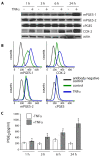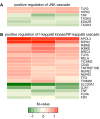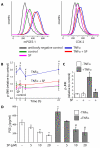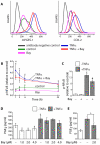Signal pathways JNK and NF-kappaB, identified by global gene expression profiling, are involved in regulation of TNFalpha-induced mPGES-1 and COX-2 expression in gingival fibroblasts
- PMID: 20398340
- PMCID: PMC2873473
- DOI: 10.1186/1471-2164-11-241
Signal pathways JNK and NF-kappaB, identified by global gene expression profiling, are involved in regulation of TNFalpha-induced mPGES-1 and COX-2 expression in gingival fibroblasts
Abstract
Background: Prostaglandin E2 (PGE2) is involved in several chronic inflammatory diseases including periodontitis, which causes loss of the gingival tissue and alveolar bone supporting the teeth. We have previously shown that tumor necrosis factor alpha (TNFalpha) induces PGE2 synthesis in gingival fibroblasts. In this study we aimed to investigate the global gene expression profile of TNFalpha-stimulated primary human gingival fibroblasts, focusing on signal pathways related to the PGE2-synthesizing enzymes prostaglandin E synthases (PGES), as well as the upstream enzyme cyclooxygenase-2 (COX-2) and PGE2 production.
Results: Microarray and western blot analyses showed that the mRNA and protein expression of the inflammatory induced microsomal prostaglandin E synthase-1 (mPGES-1) was up-regulated by the cytokine TNFalpha, accompanied by enhanced expression of COX-2 and increased production of PGE2. In contrast, the expression of the isoenzymes microsomal prostaglandin E synthase-2 (mPGES-2) and cytosolic prostaglandin E synthase (cPGES) was unaffected by TNFalpha treatment. Using oligonucleotide microarray analysis in a time-course factorial design including time points 1, 3 and 6 h, differentially expressed genes in response to TNFalpha treatment were identified. Enrichment analysis of microarray data indicated two positively regulated signal transduction pathways: c-Jun N-terminal kinase (JNK) and Nuclear Factor-kappaB (NF-kappaB). To evaluate their involvement in the regulation of mPGES-1 and COX-2 expression, we used specific inhibitors as well as phosphorylation analysis. Phosphorylation analysis of JNK (T183/Y185) and NF-kappaB p65 (S536) showed increased phosphorylation in response to TNFalpha treatment, which was decreased by specific inhibitors of JNK (SP600125) and NF-kappaB (Bay 11-7082, Ro 106-9920). Inhibitors of JNK and NF-kappaB also decreased the TNFalpha-stimulated up-regulation of mPGES-1 and COX-2 as well as PGE2 production.
Conclusion: In the global gene expression profile, the enrichment analysis of microarray data identified the two signal transduction pathways JNK and NF-kappaB as positively regulated by the cytokine TNFalpha. Inhibition of these TNFalpha-activated signal pathways reduced the expression of mPGES-1 and COX-2 as well as their end product PGE2 in gingival fibroblasts. The involvement of the signal pathways JNK and NF-kappaB in the regulation of PGE2 induced by TNFalpha may suggest these two pathways as possible attractive targets in the chronic inflammatory disease periodontitis.
Figures








Similar articles
-
Signal pathways involved in the regulation of prostaglandin E synthase-1 in human gingival fibroblasts.Cell Signal. 2006 Dec;18(12):2131-42. doi: 10.1016/j.cellsig.2006.04.003. Cell Signal. 2006. PMID: 16766159
-
Regulation of prostaglandin E synthases: effects of siRNA-mediated inhibition of microsomal prostaglandin E synthase-1.Biochim Biophys Acta. 2007 Oct;1773(10):1589-98. doi: 10.1016/j.bbamcr.2007.07.008. Epub 2007 Aug 2. Biochim Biophys Acta. 2007. PMID: 17707523
-
Triclosan reduces microsomal prostaglandin E synthase-1 expression in human gingival fibroblasts.J Clin Periodontol. 2005 Jan;32(1):6-11. doi: 10.1111/j.1600-051X.2004.00622.x. J Clin Periodontol. 2005. PMID: 15642051
-
Prostaglandin E2 as a mediator of fever: synthesis and catabolism.Front Biosci. 2004 May 1;9:1977-93. doi: 10.2741/1383. Front Biosci. 2004. PMID: 14977603 Review.
-
Pathophysiological role of prostaglandin E synthases in liver diseases.Prostaglandins Other Lipid Mediat. 2021 Jun;154:106552. doi: 10.1016/j.prostaglandins.2021.106552. Epub 2021 Apr 27. Prostaglandins Other Lipid Mediat. 2021. PMID: 33930567 Review.
Cited by
-
Microsomal Prostaglandin E Synthase-1 Expression in Inflammatory Conditions Is Downregulated by Dexamethasone: Seminal Role of the Regulatory Phosphatase MKP-1.Front Pharmacol. 2017 Sep 21;8:646. doi: 10.3389/fphar.2017.00646. eCollection 2017. Front Pharmacol. 2017. PMID: 28983247 Free PMC article.
-
Age-Associated Increase in Skin Fibroblast-Derived Prostaglandin E2 Contributes to Reduced Collagen Levels in Elderly Human Skin.J Invest Dermatol. 2015 Sep;135(9):2181-2188. doi: 10.1038/jid.2015.157. Epub 2015 Apr 23. J Invest Dermatol. 2015. PMID: 25905589 Free PMC article.
-
Ocular fibroblast diversity: implications for inflammation and ocular wound healing.Invest Ophthalmol Vis Sci. 2011 Jul 1;52(7):4859-65. doi: 10.1167/iovs.10-7066. Invest Ophthalmol Vis Sci. 2011. PMID: 21571679 Free PMC article.
-
The Role of Gingival Fibroblasts in the Pathogenesis of Periodontitis.J Dent Res. 2023 May;102(5):489-496. doi: 10.1177/00220345231151921. Epub 2023 Mar 8. J Dent Res. 2023. PMID: 36883660 Free PMC article. Review.
-
Aberrant expression of the COX2/PGE2 axis is induced by activation of the RAF/MEK/ERK pathway in BRAFV595E canine urothelial carcinoma.Sci Rep. 2020 May 8;10(1):7826. doi: 10.1038/s41598-020-64832-5. Sci Rep. 2020. PMID: 32385388 Free PMC article.
References
-
- Bascones A, Noronha S, Gomez M, Mota P, Gonzalez Moles MA, Dorrego MV. Tissue destruction in periodontitis: bacteria or cytokines fault? Quintessence Int. 2005;36:299–306. - PubMed
Publication types
MeSH terms
Substances
LinkOut - more resources
Full Text Sources
Research Materials
Miscellaneous

